Artnet News Pro
Art Dealers Are Repping Their Local Roots at Felix L.A. and the City’s First Gallery Weekend—and Sales Are Coming in ‘Like a Firehose’
Los Angeles, the U.S. art epicenter that's been slowest to reopen, is back in business.

Los Angeles, the U.S. art epicenter that's been slowest to reopen, is back in business.

In many cities, the art world began to wake from its pandemic slumber toward the middle of 2020. New York’s galleries started opening appointment-only for mask-wearing visitors, and museums started letting people back in by the end of the season, with the Met opening for members by mid-August. Other cities were even more aggressive. The MFA Houston was open by May, and institutions in Florida started to open by June.
MOCA in Los Angeles opened in June—June 2021, that is, nearly 15 months after closing its doors. While the more laissez-faire (er, that’s one way to put it) states let people go back to relative normalcy after a few months, L.A. kept its institutions in lockdown for what seemed like an eternity. World-class art centers such as the Broad, the Hammer, and LACMA were shuttered until a month or so before that. More than perhaps any other city in the states, Los Angeles has taken an aggressive stance on the process of returning to whatever normal is.
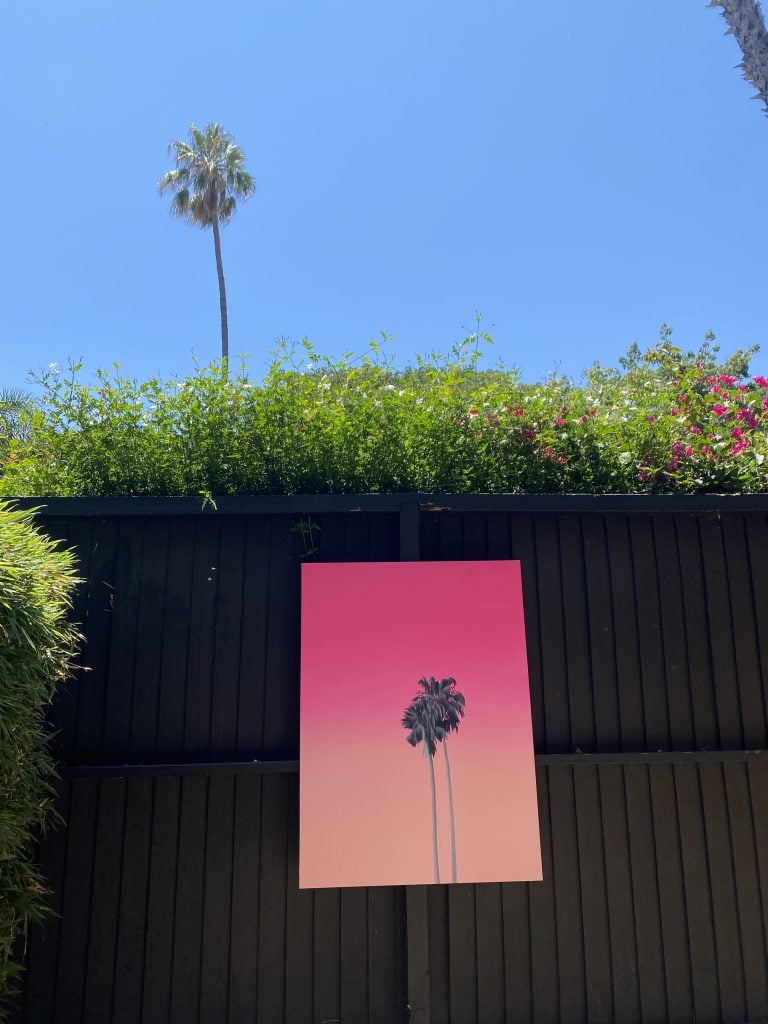
The outside space at the Anat Ebgi booth. Photo by Nate Freeman.
On Thursday, the city cleared another hurdle: It successfully opened an art fair. At 11:00 am PST, a Cali-heavy crew of V.I.P.s streamed into the Hollywood Roosevelt hotel—which more than any other place in this fabled neighborhood exudes the pure spirit of Golden-era Tinseltown, with the hum of celluloid glamor turned up to 11—for the third edition of Felix L.A., the fair that was founded in February 2019 by Morán Morán proprietors Mills and Al Morán, alongside longtime collector and patron Dean Valentine. Months after New York held a successful edition of Frieze, and weeks after 20,000 visitors attended ARCO Madrid, the City of Angels now can say that it has returned to the way of the art fair.
“The galleries having been selling work, and the art market has been strong, but what’s been missing in a major way is a sense of community and engagement,” Mills Morán said. “Online viewing rooms? That’s not how dealers really think. You have to be together with the work, face-to-face, and see faces we haven’t seen in a along time.”
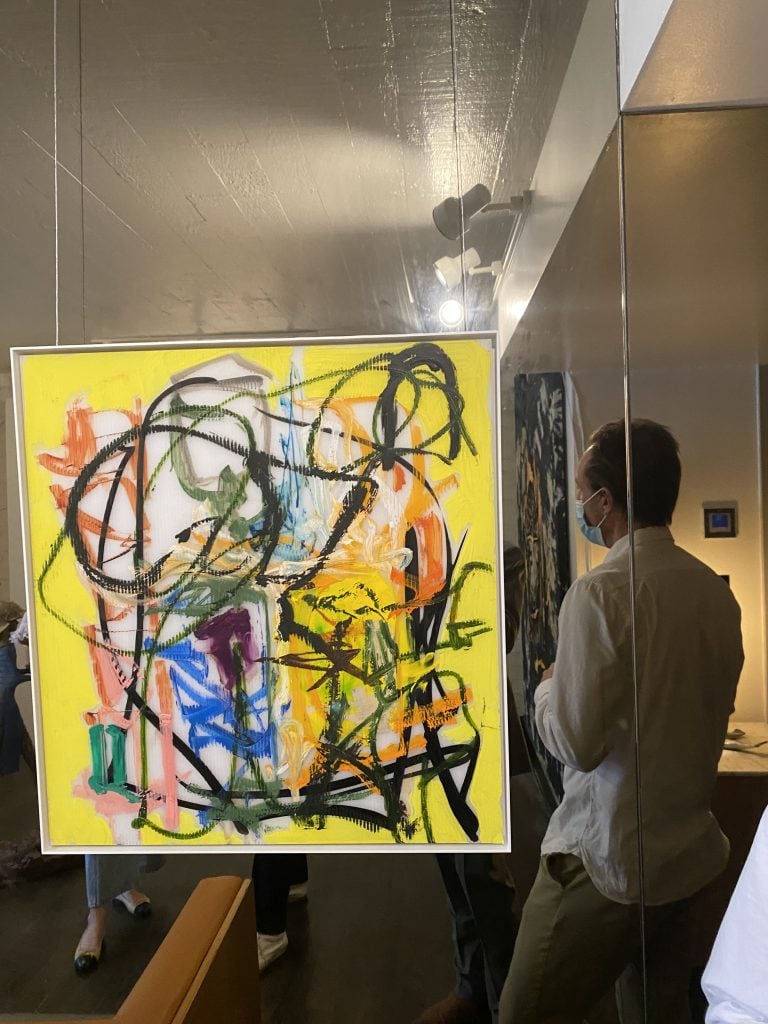
A work by Aaron Garber-Maikovska in the Clearing booth. Photo by Nate Freeman.
Felix, which takes place at the suite-filled hotel that played host to the first-ever Oscars ceremony, is also happening during the first-ever L.A. Gallery Weekend, organized by the Gallery Association of Los Angeles (GALA for short), which formed during the depths of the pandemic to forge bonds between art spaces in the city. Few people expected that bond in February 2020, when visitors descended on the West Coast for the second editions of Felix and Frieze Los Angeles.
Yes, Europeans and New Yorkers have finally come see Tinseltown as more than a one-industry city with slavish devotion to showbiz, and admitted it can be a place where individual galleries can thrive alongside the longstanding network of artists who take advantage of the ample amounts of studio space. But there’s no way around it: for the most part, during the other 51 weeks of the year, galleries in this city seem mostly kept themselves, having been prevented from creating the bonds that exist in walkable (or at least bikeable) cities like New York or Berlin. It’s hard to have a tight network when it takes an hour to get from one gallery to another.
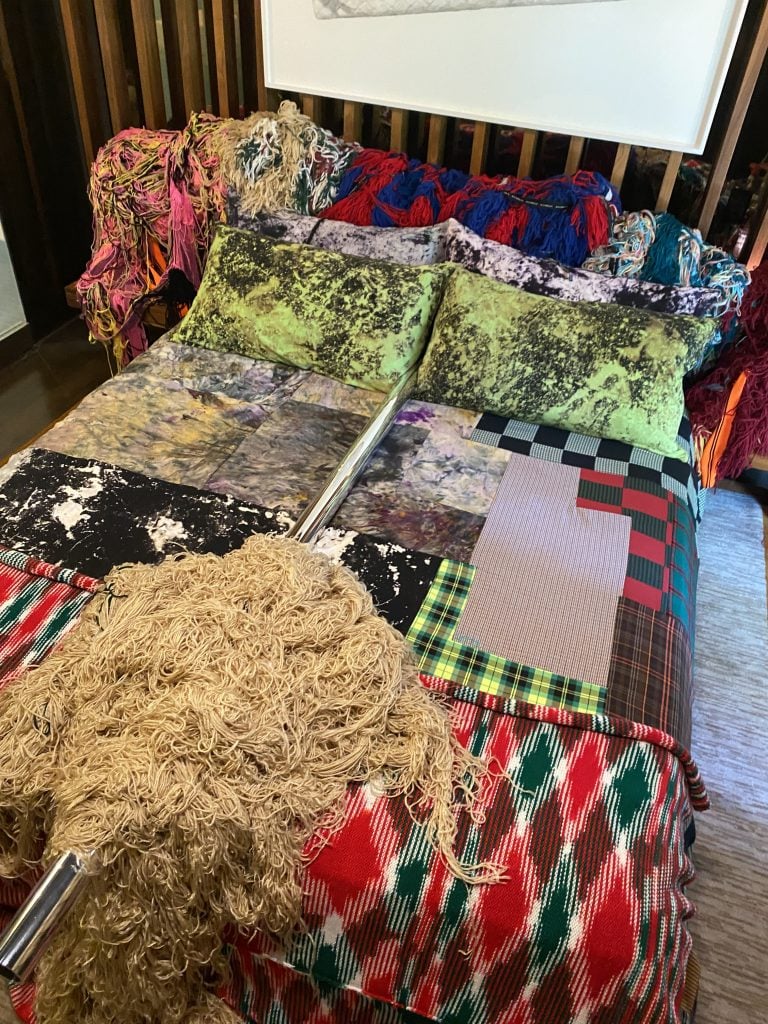
A sculpture by Sterling Ruby in the Gagosian booth at Felix. Photo by Nate Freeman.
The pandemic changed that. David Zwirner’s Platform L.A. finally eliminated the distance between shops by letting fellow Angelenos exist on a digital plane together. After seeing how such collectivity could benefit everybody, L.A. dealers formed GALA, with Blum & Poe co-founder Tim Blum acting as a mentor to younger upstarts. As a result, the connective wiring running through the L.A. art scene is more tightly knit than at any time since before the pandemic—and possibly more than ever. Olivia Barrett, proprietor of the beloved local gallery Chateau Shatto, said that she’d never experienced this level of collaboration between galleries in her decade in the city.
Like many dealers in town, Barrett took the opportunity to put up a blockbuster show while energy levels were high, and invited people over to her Fashion District gallery on Saturday to see new works by Helen Johnson, the Australian artist who’s been with the gallery since 2014. The masterful canvases hang unframed from the roof of the gallery, and all sold to institutions or prominent collectors by the time the show officially opened Thursday.
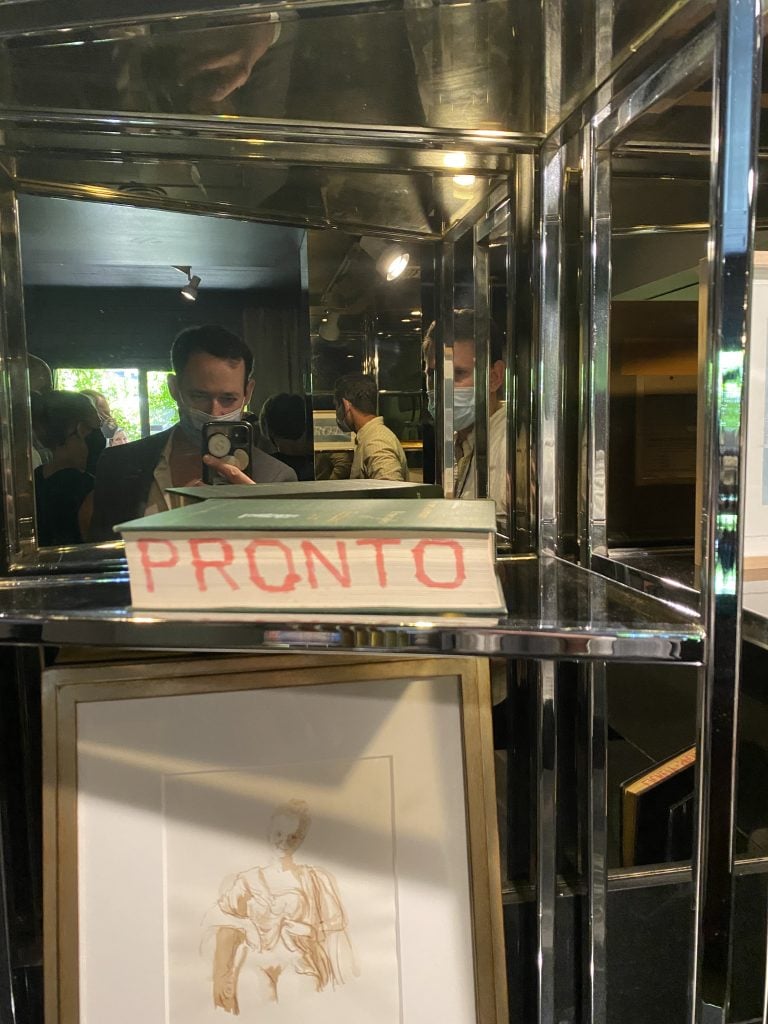
A book spine work by Ed Ruscha. Photo by Nate Freeman.
Elsewhere in town, the young upstart Matthew Brown had a show of work by Tarwuk, the hot Croatian collective that has previously shown at Martos and 15 Orient in New York. Nearby is Jeffrey Deitch’s citadel, which has a show of new works by Nari Ward. There were some off-campus projects, such as a show arranged by the artist Lucy Bull in which her artist friends designed hermit crab shells and then placed them on Topanga Beach just south of Malibu, hoping to give a shell-less crab a new home.
(I was hoping to see the project, and rented a bike at the Santa Monica pier to take it up to Topanga Beach, but found out that the path did not extend beyond Will Rogers State Park. Oh well. I ran into Bull that night at El Prado, the Echo Park wine bar that acts as a de facto clubhouse for east side artists, and she said that many of the crabs did in fact find new homes. Good for them!)
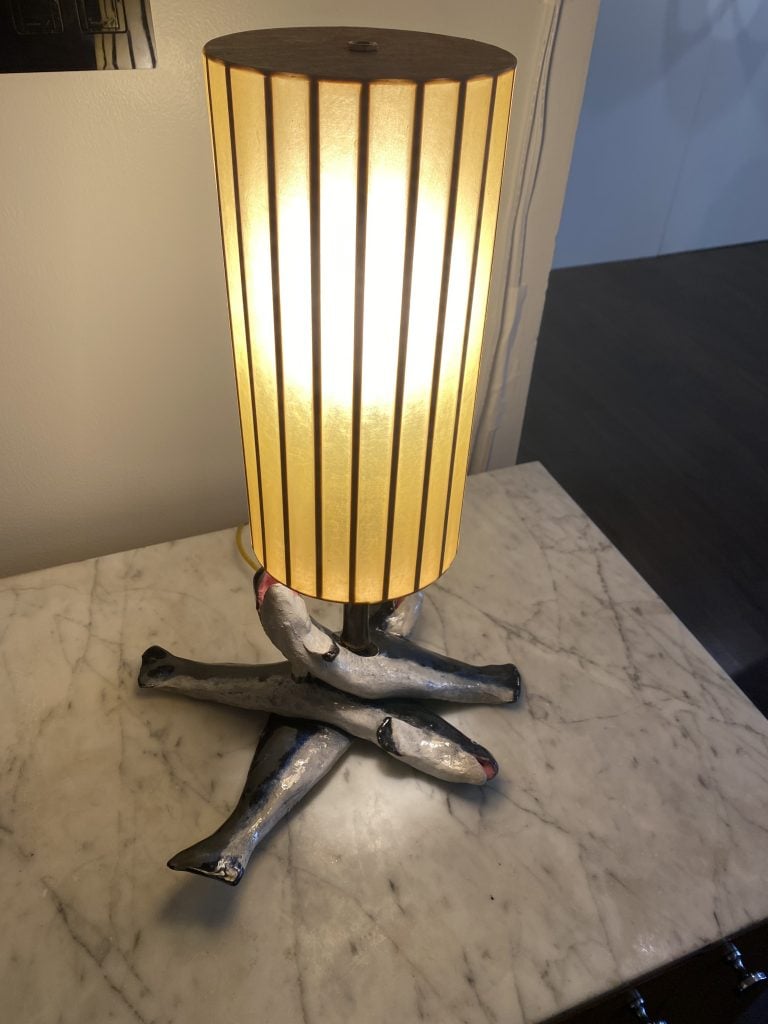
A Calvin Marcus lamp at the Clearing booth. Photo by Nate Freeman.
In Beverly Hills, Clearing, the tastemaking gallery with spaces in Bushwick and Brussels, has sold out a show of paintings by Calvin Marcus, all on view in a stately mansion he’s been staging shows out of since the middle of the pandemic.
Marcus has more work from the same series at Felix, with David Kordansky Gallery, which is doing the fair for the first time. The fair is all-L.A. galleries, and maintains a locals-only vibe. Joining Kordansky in participating in Felix for the first time is Gagosian, which Larry technically founded in New York. But Gago’s roots are on the West Coast, and he opened his Beverly Hills space in 1999.
Instead of bringing a tired grab bag of the same secondary market whatever, Gagosian set up a booth in which L.A. played itself, with examples by local artists such as Ed Ruscha and Duane Hanson, plus a sensational sculpture by Sterling Ruby installed in a bedroom. (It’s a bed, and it is not for sale, but the Hanson was available, with a price tag of $500,000.) The gallery also asked Piero Golia to make an artwork that would make sense in a cabana, and Golia made an installation that operated as a mister, spraying a haze of water imported from Positano onto the sun-drunk visitors.
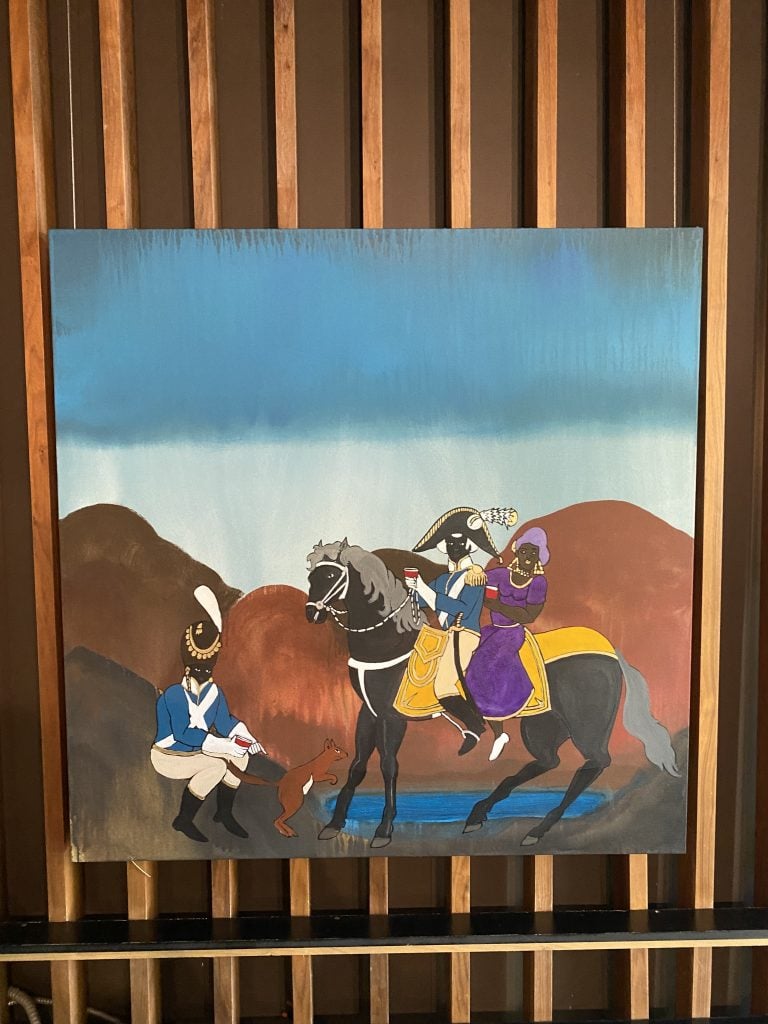
A work by Umar Rashid at the Blum & Poe booth. Photo by Nate Freeman.
“This hotel, it’s so ridiculous. I mean this hotel is a lot. And one of the things we were trying to do was make it fun, and not like a regular art fair booth,” a rep for Gagosian said.
It’s hard not to have fun at a fair that’s held poolside, and the V.I.P.s basking in the watery reflections seemed to be having a blast soaking up both sun and art. Kim Gordon lunched by the cabanas as actor Eric Andre waltzed up to some collector buddies. Two former MOCA boys—Paul Schimmel and Jeffrey Deitch—were present, though not Klaus Biesenbach, who the board recently remanded as “artistic director.” And the collectors were around as well, including Sam Schwartz, Frank Moore, and Don and Mera Rubell.
“Don and Mera were sitting on the couch here for 10 minutes, and that’s never happened to me, that’s never happened at a fair anywhere,” said Charlie James, the proprietor of his eponymous gallery in Chinatown.
I remembered that the Rubells were big John Ahearn collectors, and saw that James had a number of Ahearn works on the booth. How’s business going?
“Sales are coming like a fucking firehouse,” James said. “And we sold a bunch before. Everyone who you could want to be here is here.”
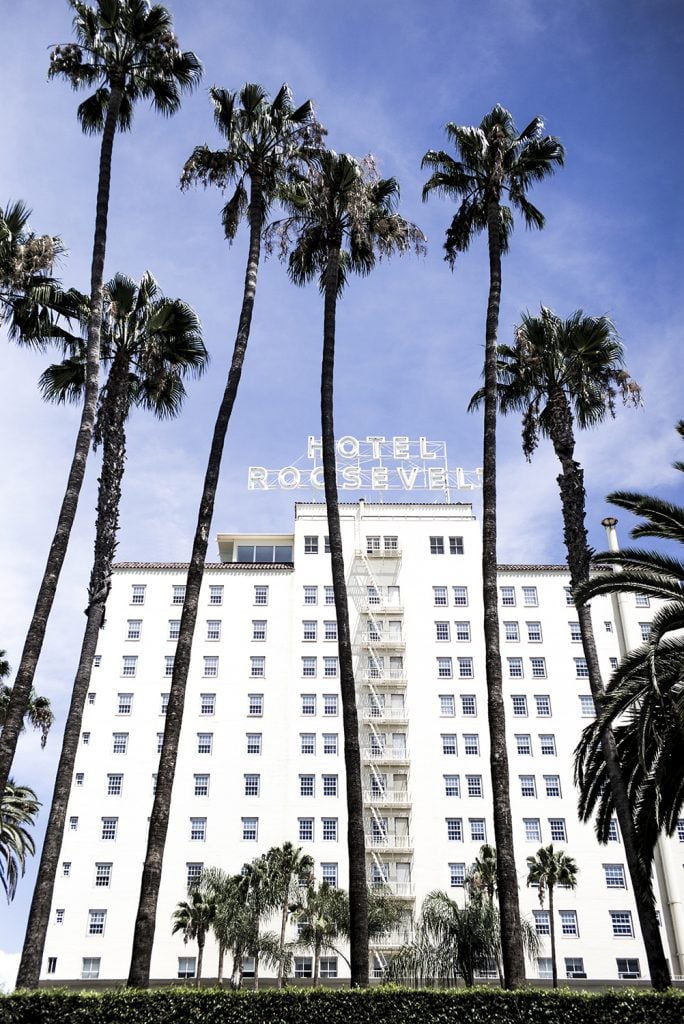
The Hollywood Roosevelt. Photo courtesy Hollywood Roosevelt.
Elsewhere, Chris Sharp sold out his booth, and Morán Morán sold 15 works from a booth that included works by SoiL Thornton, David Benjamin Sherry, and the extremely in-demand Tunji Adeniyi-Jones.
It’s a busy week for Mills and Al Morán—in addition to running the fair, they’re also readying their new space on Western Avenue and Melrose Avenue. It’s in the heart of a new art micro-neighborhood that will bring together not just L.A. galleries relocating to a new nexus, but also East Coast galleries opening their first outposts in the City of Angels. Though the buildout hasn’t begun in earnest, David Zwirner will be opening his first gallery out west in a former furniture store on Western, right about diagonal from Morán Morán.
“Hopefully you can park once and see eight galleries by the end of the day, both local galleries and new ones from out of town,” Morán said. “In some ways, it was inevitable. Since the beginning of time there’s been a migration to the west.”